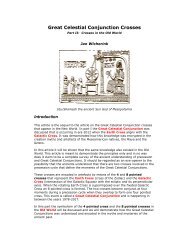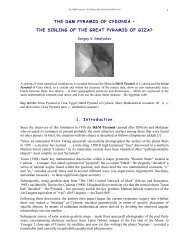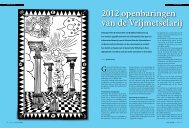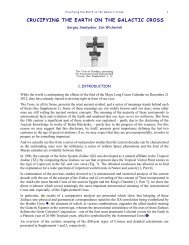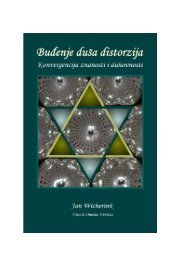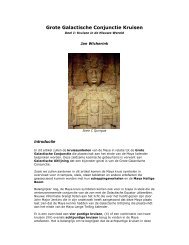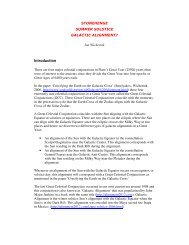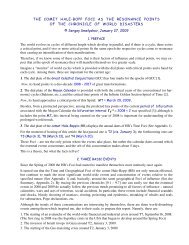Thusanang - Souls of Distortion
Thusanang - Souls of Distortion
Thusanang - Souls of Distortion
Create successful ePaper yourself
Turn your PDF publications into a flip-book with our unique Google optimized e-Paper software.
<strong>Thusanang</strong><br />
Lesotho Community<br />
and Family based<br />
Vulnerable Children’s<br />
Care Centre Project<br />
Project description including<br />
Pilot Project at Mount Moorosi<br />
Version 2.3.1 20 March 2006<br />
Project Summary .......................................... 1<br />
The Problem.................................................. 2<br />
The Need........................................................ 2<br />
Proposed Project.......................................... 4<br />
Sustainability ................................................ 5<br />
Project Timeline............................................ 7<br />
Credentials .................................................... 7<br />
Contact .......................................................... 8<br />
Project Budget .............................................. 9<br />
Evaluation.................................................... 13<br />
Back Up Plan............................................... 17
Project Summary<br />
The overall objective <strong>of</strong> this project is to relieve the<br />
suffering <strong>of</strong> orphans and vulnerable children in Lesotho in<br />
Africa through the planning, financing, construction,<br />
staffing, maintenance and ongoing operation <strong>of</strong><br />
Community and family based Vulnerable Children’s Care<br />
Centres.<br />
The initial goal is to create a pilot project at Mount Moorosi, a village<br />
in the Quthing District <strong>of</strong> Lesotho with documented significant highrisk<br />
orphan populations. The centre will either be built or existing<br />
buildings extended in low cost traditional Basotho style and will<br />
include a kitchen for feeding vulnerable children and orphans, toilet<br />
and bathing facilities, space for educational, counselling and<br />
vocational skill building programming, as well as a few beds for shortterm<br />
housing. Agricultural and other skills will be promoted to<br />
encourage self-sustainability and to reduce food costs to the centre.<br />
Lesotho is a small independent, beautiful<br />
but poverty stricken mountainous landlocked<br />
kingdom in Southern Africa. It has a<br />
population <strong>of</strong> approximately 2.5 million<br />
Africans known as Basotho in plural and as<br />
Mosotho in singular. The <strong>of</strong>ficial HIV/AIDS<br />
infection rate is over 30% however, many<br />
believe it in reality to be over 50%.<br />
There are over 200,000 orphans <strong>of</strong> which<br />
100,000 are estimated to be HIV/AIDS<br />
related.<br />
The Kingdom <strong>of</strong> Lesotho is made up <strong>of</strong> 10<br />
districts, each having approximately 250<br />
villages.<br />
The lifestyle is generally rural with only one<br />
large town, Maseru, the capital, in the<br />
country.<br />
Lesotho has experienced drought and<br />
famine over the last three years.<br />
A minimum <strong>of</strong> ongoing operational funding will be necessary to<br />
sustain each centre beyond the building/extension and furnishing <strong>of</strong><br />
the original facilities. The sustainability <strong>of</strong> this project is based on the<br />
non-denominational management and staffing <strong>of</strong> these centres by the<br />
Basotho villagers themselves. Volunteers from the village and<br />
existing community resources will be utilized to provide ongoing<br />
programming and support.<br />
A core value and activity <strong>of</strong> this project will be the counselling,<br />
support and placement <strong>of</strong> vulnerable children and orphans with<br />
extended families.<br />
It is envisaged that this project will initially be organized and<br />
coordinated by the Catholic Church within the Diocese <strong>of</strong> Qacha’s<br />
Nek, Rotary Lesotho and Rotary International, Lovelight <strong>of</strong> Byron Bay<br />
<strong>of</strong> Australia and other stakeholders. The children’s care centre will<br />
be immediately managed by the non-denominational <strong>Thusanang</strong><br />
Committees which will include the existing non-denominational<br />
humanitarian Justice and Peace Committees already set up by the<br />
Catholic Church, made up <strong>of</strong> the villagers themselves and set up<br />
within Mount Moorosi.<br />
The basic belief in Divinity itself and the five human values <strong>of</strong> Truth,<br />
Love, Peace, Goodness and Non-Violence and the giving <strong>of</strong> selfless<br />
service will form the core functioning <strong>of</strong> this project.<br />
This project is seen as a potential blue print for sustainable African<br />
community and family-based and village-run vulnerable children’s<br />
care centres required to address the growing HIV/AIDS pandemic<br />
that is sweeping Africa. An evaluation plan will be built into the design<br />
<strong>of</strong> this project so that we can test the viability <strong>of</strong> this concept and<br />
duplicate it if successful in other parts <strong>of</strong> Lesotho and Africa. We<br />
believe our proposed project represents ‘best practices’ as articulated<br />
in many United Nations documents and also adheres to the<br />
philosophy <strong>of</strong> the Lesotho government on dealing with the orphan<br />
crisis in this country.<br />
The project will cater for all vulnerable children whether HIV/AIDS<br />
related or not.<br />
While every effort will be made, as part <strong>of</strong> this project, to keep<br />
vulnerable children with appropriate village extended family units, we<br />
recognize that such prospects do not exist for all children who are<br />
orphaned. By extension, a further goal <strong>of</strong> this project is the potential<br />
development <strong>of</strong> new family units i.e., foster mother (and father where<br />
1
possible), and groupings <strong>of</strong> individual children and brothers and<br />
sisters who can provide each other with mutual support.<br />
The cost <strong>of</strong> this initial 2 year phase <strong>of</strong> the project is AUD520,000<br />
which will support 350 orphans and vulnerable children and enable<br />
the construction <strong>of</strong> a simple elegant operational Child Care Centre at<br />
Mount Moorosi (we have assumed support for half <strong>of</strong> the estimated<br />
700 orphans and vulnerable children at Mount Moorosi). This<br />
document is being distributed to obtain this funding to enable this<br />
project to continue.<br />
The Problem<br />
The vast beautiful isolation <strong>of</strong> the highlands<br />
which form a large part <strong>of</strong> Lesotho. Living<br />
in these harsh regions is very difficult.<br />
Lesotho is a land-locked mountain kingdom surrounded<br />
by South Africa. The economy is heavily dependent on<br />
agriculture and exporting water and labour to the South<br />
African mines. There has been a significant amount <strong>of</strong><br />
retrenchment <strong>of</strong> workers from the mines over the past five<br />
years, leaving many families with little or no income.<br />
Many <strong>of</strong> the miners also returned to Lesotho with HIV/AIDS and other<br />
chronic health problems. According to the HIV/AIDS surveillance<br />
data reported by the Ministry <strong>of</strong> Health and Social Welfare (2000), the<br />
HIV prevalence rate in the country is 30%. In a joint report issued by<br />
UNAIDS/UNICEF/UNAID, ‘Children on the Brink’ (2002), it was<br />
reported that by 2003 there would be an estimated 180,000 orphans<br />
in Lesotho, with 100,000 orphaned by AIDS and 49,000 <strong>of</strong> those<br />
children documented as double orphans (both parents deceased).<br />
On a recent fact-finding mission conducted by Lovelight <strong>of</strong> Byron Bay<br />
and the Justice and Peace Committee, our team visited three primary<br />
schools in the Qachas Nek and Quthing Districts and discovered that<br />
between one third and one half <strong>of</strong> the student body (135 students)<br />
were orphaned with approximately 100 single orphans and 25 to 35<br />
double orphans.<br />
The Need<br />
Orphans in Lesotho need alternatives to institutional care<br />
where extended families do not exist or cannot afford to<br />
care for them any longer. While the Lesotho village social<br />
structure provides extended family support for many <strong>of</strong><br />
the orphans, in many villages there remain dozens <strong>of</strong><br />
vulnerable children who are homeless, uncared for,<br />
sexually abused or at risk for other forms <strong>of</strong> exploitation,<br />
including prostitution.<br />
According to the United Nations Children’s Fund (Bjorn Ljungqvist,<br />
2003), ‘...throughout sub-Saharan Africa, there have been traditional<br />
systems in place to take care <strong>of</strong> children who lose their parents for<br />
various reasons. But the onslaught <strong>of</strong> HIV slowly but surely erodes<br />
this good traditional practice by simply overloading its caring capacity<br />
by the sheer number <strong>of</strong> orphaned children needing support and care.<br />
HIV also undermines the caring capacity <strong>of</strong> families and communities<br />
by deepening poverty due to loss <strong>of</strong> labour and the high cost <strong>of</strong><br />
medical treatment and funerals’<br />
Basotho village children<br />
Keeping orphans in school is crucial to their futures. While primary<br />
education is basically free in Lesotho through 7 th grade (as <strong>of</strong> 2005),<br />
many orphans are not in school due to extended family not being<br />
interested in educating them or able to afford other school fees.<br />
According to UNAID report ‘The Global HIV Epidemic, 2002’, 52% <strong>of</strong><br />
2
the children orphaned by AIDS in Kenya were not in school<br />
compared to 2% among non-orphans. Stephen Lewis, UN Special<br />
Envoy for HIV/AIDS in Africa, stated in his report ‘Africa Recovery<br />
(2001)’, ‘There has to be a Herculean effort made for these kids so<br />
we don’t lose them. Otherwise you will have a society where kids<br />
haven’t been to school and therefore can’t fulfil even basic jobs...a<br />
society where a large proportion can have anti-social instincts<br />
because their lives have been so hard. You have a generation <strong>of</strong><br />
children who will be more vulnerable to exploitation and to disease<br />
because they won’t have the same sense <strong>of</strong> self-worth’. One <strong>of</strong> the<br />
goals <strong>of</strong> this project will be to encourage orphans to remain in school<br />
and/or to provide educational opportunities on site including<br />
vocational and agricultural skill-building.<br />
According to several studies, orphans are thought to be at greater<br />
risk for being malnourished and stunted due to their general lack <strong>of</strong><br />
access to regular nutrition. Both ‘malnutrition and illness are<br />
associated with children who are alone after the death <strong>of</strong> their<br />
parents’ (pg. 225, ‘Turning A Crisis Into An Opportunity; Strategies<br />
For Scaling Up The National Response to the HIV/AIDS Pandemic--<br />
UNDP). This <strong>Thusanang</strong> project seeks to provide at least two solid<br />
meals each day for both double and single orphans in each village.<br />
Winter in Lesotho is extremely cold. Many<br />
<strong>of</strong> the mountains and the approximately<br />
2,500 villages are around 2,500 to 3,000<br />
metres above sea level, some even higher.<br />
Large tracts <strong>of</strong> Lesotho are covered in snow<br />
for many months in Winter, making the life<br />
<strong>of</strong> the poverty stricken Basotho people very<br />
difficult.<br />
For AIDS orphans in particular, counselling and emotional support is<br />
essential. ‘These children suffer pr<strong>of</strong>oundly as their parents fall sick<br />
or die, with their experience characterized by psychosocial distress<br />
from their parents illness or death, which is worsened by the stigma<br />
and shame associated with HIV/AIDS. The psychosocial impact <strong>of</strong><br />
caring for ill and dying parents cannot be overestimated. It can affect<br />
schoolwork and the ability to keep up in class. There is also the<br />
obvious hardship in relation to the inability <strong>of</strong> the parents to work,<br />
resulting in children being forced to take on frightening adult<br />
responsibilities’ (pg. 225, ‘Turning A Crisis Into An Opportunity;<br />
Strategies For Scaling Up The National Response to the HIV/AIDS<br />
Pandemic’ (UNDP) ). The toll on the family structure and the rush <strong>of</strong><br />
these children into parental roles complicates their passage to<br />
adolescence and adulthood.<br />
In consultation with the Bishop <strong>of</strong> Qacha’s Nek, a pilot site has been<br />
chosen at the village <strong>of</strong> Mount Moorosi in the district <strong>of</strong> Quthing.<br />
We are currently collecting hard evidence on orphans at Mount<br />
Moorosi and so far we have registered 140 double orphans (children<br />
with no mothers or fathers).<br />
We believe even these statistics we have collected are not complete.<br />
UNICEF estimates 200,000 orphans in Lesotho, which translates to<br />
an average <strong>of</strong> about 80 orphans per village assuming 2,500 villages<br />
in Lesotho.<br />
3
Proposed Project<br />
The Justice and Peace Department <strong>of</strong> the Catholic<br />
Diocese <strong>of</strong> Qacha’s Nek and Lovelight <strong>of</strong> Byron Bay<br />
propose to build a Community and family based<br />
Vulnerable Children’s Care Centre pilot at the village <strong>of</strong><br />
Mount Moorosi in the district <strong>of</strong> Quthing over the next two<br />
years.<br />
The Children’s Care Centre will all be designed in the traditional<br />
Basotho style and will be built with local labour and local materials<br />
(stones, mud, thatch) and will be built with the cooperation and<br />
selfless service <strong>of</strong> the local Basotho community. The Catholic Church<br />
has donated land for the pilot Centre. The Centre with include the<br />
following features:<br />
• A kitchen for feeding double orphans and single orphans<br />
• Toileting and bathing facilities<br />
• Temporary sleeping accommodation for homeless and<br />
abused orphans<br />
• Quarters for a ‘mother’ who will live on site and provide<br />
support, counselling, supervision and cooking<br />
• Educational and vocational training space<br />
The beauty <strong>of</strong> a Mother.<br />
As well as providing the children with a foster mother, nourishing<br />
food, caring support, good clothing and shelter, programming will be<br />
provided on-site through various pr<strong>of</strong>essional partnerships including<br />
educational activities for out-<strong>of</strong>-school youth (Peace Corps will be<br />
asked to provide an ongoing placement <strong>of</strong> a teacher/volunteer on a<br />
two year rotation); counselling (Ministry <strong>of</strong> Health and Social<br />
Welfare); and vocational and life-skill training (agriculture, carpentry,<br />
arts and crafts, IT, etc.) utilizing local or village volunteers.<br />
A <strong>Thusanang</strong> Committee composed <strong>of</strong> good people in the local<br />
community will manage the project. The concept <strong>of</strong> selfless service<br />
will be encouraged, ie. the giving <strong>of</strong> one’s time and skills at no cost.<br />
The project will be run by a three personnel team, with the periodic<br />
engagement <strong>of</strong> consultants for special activities.<br />
There will be a project coordinator (PC) whose responsibilities will<br />
include but be not limited to oversee all project objectives, monitor<br />
proper implementation <strong>of</strong> project activities, control staff and assets,<br />
liaison with donors, interact with communities, and furnish reports to<br />
interested parties.<br />
There will be an Administration and Finance Officer (AFO) whose<br />
function will include management <strong>of</strong> all financial matters relating to<br />
the project, including budgets, purchases, contracts and<br />
documentation <strong>of</strong> OVC (Orphans & Vulnerable Children) pr<strong>of</strong>iles and<br />
all other project information.<br />
There will be a Care Giver (CG) (mother): The mother’s responsibility<br />
shall be to counsel and maintain the welfare <strong>of</strong> all OVC, whether they<br />
use the drop-in service or are temporary residents, and keep the<br />
centre clean at all times. The mother will be expected to reside at the<br />
Care Centre.<br />
4
Sustainability<br />
The basis <strong>of</strong> personal involvement <strong>of</strong> all care-givers<br />
(Basotho and all others) in the project is that <strong>of</strong> selfless<br />
service. (ie. The human desire to help one another<br />
through the active experience <strong>of</strong> Divinity and the five<br />
human values <strong>of</strong> Truth, Love, Peace, Goodness and Non-<br />
Violence). In fact, the name <strong>of</strong> the project ‘<strong>Thusanang</strong>’ is<br />
the Sesotho word that encompasses this sweet<br />
experience.<br />
The great resource <strong>of</strong> Africa is the availability <strong>of</strong> people’s time.<br />
World Food Program food distribution in<br />
Lesotho. We have already approached<br />
WFP and other humanitarian<br />
organisations to give food for our<br />
<strong>Thusanang</strong> Vunerable Children project.<br />
Initial indications are promising.<br />
While project donated capital<br />
funds will be used to build<br />
facilities, ongoing costs<br />
potentially can be paid out <strong>of</strong><br />
interest earned on further<br />
donated capital. This form <strong>of</strong><br />
ongoing financing can help<br />
ensure sustainability.<br />
Alternatively, for financing <strong>of</strong><br />
ongoing sustainability donors<br />
need not bequest capital, but<br />
may prefer to bequest interest<br />
on capital as an ongoing<br />
donation.<br />
In line with these human sentiments, the active participation <strong>of</strong><br />
individuals will be the key to the success <strong>of</strong> this project both in<br />
sharing their skills as volunteers and in providing monetary<br />
donations. Both Lovelight <strong>of</strong> Byron Bay and the Diocesan Justice and<br />
Peace Committee will focus on seeking out individual donors,<br />
corporate, foundation and international aid support for the planning,<br />
construction, ongoing expenses and evaluation <strong>of</strong> the pilot centre for<br />
the first two years <strong>of</strong> existence. The over-riding goal <strong>of</strong> the project is<br />
to create Centres throughout Lesotho which will need very little<br />
ongoing operating revenue beyond the original construction. Things<br />
like routine facility maintenance will hopefully be donated by the<br />
villagers for example through the local Justice and Peace Committee<br />
structure. We plan to provide ongoing nutritional support by growing<br />
crops and utilizing international food programs when available.<br />
Ongoing grant funding and donations will hopefully support the other<br />
day to day expenses. All other services will be provided by volunteers<br />
(teachers, craftsman, agricultural experts) or existing community<br />
agencies whose mission is to serve this population (i.e. governmental<br />
entities or charities).<br />
Ultimately, the Diocesan Justice and Peace Committee will provide<br />
long term support and guidance to ensure the success <strong>of</strong> this project<br />
into the future. If the two-year evaluation plan indicates it is a<br />
success, further funding will be sought to implement further<br />
<strong>Thusanang</strong> centres in more villages within the surrounding Districts.<br />
Because this vulnerable children’s project is village based and village<br />
managed, we believe this ‘<strong>Thusanang</strong>’ project is a loving, caring<br />
practical sustainable and extendable family based model developed<br />
in response to the HIV/AIDS pandemic sweeping the African<br />
continent.<br />
<strong>Thusanang</strong> may thus form a basis for a new African village support<br />
system for the more than 50 million African orphans by the year 2010<br />
(UNICEF statistics).<br />
Community Ownership and Involvement<br />
The whole concept <strong>of</strong> <strong>Thusanang</strong> is that the Child Care Centre<br />
belongs to the community, is part <strong>of</strong> the community and is built,<br />
maintained, operated, managed and supported by the community.<br />
The voluntary community <strong>Thusanang</strong> Committee manages the Child<br />
Care Centre.<br />
The local community supply labour and materials and supplies where<br />
possible as selfless service.<br />
5
Local and Overseas skilled volunteers<br />
The <strong>Thusanang</strong> project can supply innovative technical and<br />
educational assistance to the community via overseas and local<br />
skilled volunteers who will transfer knowledge <strong>of</strong> use to the<br />
community and the project. Examples include agriculture,<br />
woodworking, building, metal working, nursing, medical and<br />
education services.<br />
<strong>Thusanang</strong> Websites<br />
The project has available to it extensive IT skills in the form <strong>of</strong> Solihin<br />
Millin, a Trustee <strong>of</strong> Lovelight <strong>of</strong> Byron Bay Charitable Trust.<br />
Sol intends to develop and maintain websites to connect and inform<br />
donors <strong>of</strong> the <strong>Thusanang</strong> project. Please have a look at<br />
www.lovelight.org.au and www.byronbayattitude.com as existing<br />
examples. These examples will be extended and improved with<br />
further transparent donor/recipient multi-media connectivity, project<br />
and activity updates, newsletters and detailed accounting <strong>of</strong> usage <strong>of</strong><br />
individual donor funds.<br />
Ongoing Fundraising Activities<br />
The Lovelight Trust and the Catholic Church and hopefully other like<br />
minded organisations (eg Rotary) will continue with ongoing<br />
fundraising activities generally in countries outside <strong>of</strong> Lesotho at<br />
individual, NGO and governmental levels.<br />
Lovelight <strong>of</strong> Byron Bay Charitable Trust is a registered not for pr<strong>of</strong>it<br />
charitable trust in Australia (NSW).<br />
Lovelight is currently applying for DGR status in Australia which will<br />
enable all Australian donations to be tax deductible for donors and<br />
donor organisations.<br />
Project Management and Documentation<br />
A major outcome <strong>of</strong> the Mount Moorosi pilot project will be full<br />
documentation for the planning and development and operation <strong>of</strong><br />
further similar Child Care Centres in other parts <strong>of</strong> Lesotho and Africa<br />
in general.<br />
The Mount Moorosi Child Care Centre will form a model for Africa,<br />
which can be visited by interested individuals and organisations.<br />
Our policy will be to freely hand out information enabling the<br />
construction and operations <strong>of</strong> further such centres by other<br />
individuals and organisations.<br />
6
Project Timeline<br />
The initial phase <strong>of</strong> the project will take two years.<br />
During this period a functioning community and family<br />
based vulnerable children’s care centre will be facilitated<br />
in Mount Moorosi in the Diocese <strong>of</strong> Qacha’s Nek,<br />
Lesotho. Ongoing evaluation, needs analysis and<br />
analysis <strong>of</strong> benefits and required changes will enable<br />
further extension <strong>of</strong> the project beyond the initial phase.<br />
February 2006:<br />
Initial research; Development <strong>of</strong> partnerships and collaborations; Site<br />
visits, Evaluations and selection (including land acquisition);<br />
Development <strong>of</strong> evaluation tools; Grant writing<br />
February 2006—March 2006:<br />
Modify and extend original <strong>Thusanang</strong> proposal. Project refinement.<br />
Proposals sent out. Initiate individual and corporate fundraising.<br />
April 2006—July 2006:<br />
Build and open Mount Moorosi Child Care Centre<br />
April 2006—January 2008:<br />
Operate Outreach Program<br />
Gather statistics on OVC and project activities<br />
August, 2006—January 2008:<br />
Implement Child Care Centre programs and evaluate project<br />
Credentials<br />
Although the success <strong>of</strong> this project will depend on many<br />
individuals as well as new and existing partnerships<br />
within the Diocese <strong>of</strong> Qachas Nek, the initial collaborating<br />
partners include:<br />
Lovelight <strong>of</strong> Byron Bay Charitable Trust (Australia) - a not for pr<strong>of</strong>it<br />
organisation (currently being registered as a charitable trust in<br />
Australia and Lesotho). Lovelight’s motto is ‘Love in Action for the<br />
enlightenment <strong>of</strong> Humanity and the upliftment <strong>of</strong> the homeless and<br />
uncared’.<br />
Lovelight is based on non-denominational Divinity itself and the five<br />
human values <strong>of</strong> Truth, Love, Peace, Goodness and Non-Violence<br />
and the giving <strong>of</strong> selfless service which forms the core functioning <strong>of</strong><br />
all Lovelight projects. Lovelight’s website is www.lovelight.org.au<br />
The Mission <strong>of</strong> the<br />
Collaborating Partners.<br />
Justice and Peace is a Pontifical Commission <strong>of</strong> the Global Catholic<br />
Church for social concern mandated to foster global progress in its<br />
following aspects:<br />
Human dignity<br />
The Common good<br />
Subsidiarity (ie. working with the vulnerable and helping them and<br />
giving them the opportunity to resolve their problems)<br />
Justice<br />
Peace<br />
Solidarity<br />
Options for the Poor<br />
Integral development<br />
7
Reconciliation<br />
Integrity <strong>of</strong> Creation (Harmonious Living)<br />
Justice and Peace Committees are elected by villagers based on<br />
human values being, Love, Compassion, Selflessness and<br />
Credibility.<br />
Machabe Machabe, is a married Masotho farmer who is currently<br />
Qachas Nek Diocese Coordinator <strong>of</strong> the Justice and Peace<br />
Department <strong>of</strong> the Catholic Church in Lesotho. Failed to sit for<br />
COSC (Cambridge Overseas Schools Certificate) examination due to<br />
financial constraints. Currently doing project management through<br />
correspondence with Southern Business School, Johannesburg,<br />
South Africa. Ntate Machabe Machabe obtained his 1 st year<br />
certificate in Project Management. Worked in the Lesotho Civil<br />
Service for 17 years as a clerical assistant with various<br />
responsibilities that included amongst others working in the Human<br />
Resource Office. Worked with rural communities for 2 years initiating<br />
Self Help Farmers Associations. Worked with the interim Quthing<br />
Local Government structure where Machabe was chairperson for the<br />
District Rural Council which was comprised <strong>of</strong> 20 community<br />
councils.<br />
Solihin Millin is the founder <strong>of</strong> Lovelight <strong>of</strong> Byron Bay Charitable Trust<br />
(Australia). Sol is an Australian citizen who was born in South Africa.<br />
He was Scholar <strong>of</strong> the Year in 1960 at Hilton College, Kwazulu/Natal.<br />
He has a 1 st class B.Sc Degree in Applied Math and Physics from<br />
Natal University in Durban. He has spent most <strong>of</strong> his pr<strong>of</strong>essional<br />
career in the Information Technology field. After raising his three<br />
children in Australia, Sol has decided to focus his energy on<br />
humanitarian efforts and selfless service to the helpless and<br />
disadvantaged in Africa, based on the teachings <strong>of</strong> Sathya Sai Baba<br />
<strong>of</strong> India.<br />
Chuck Kuehn, Volunteer, United States Peace Corps<br />
Chuck has a Masters Degree in Social Work from the University <strong>of</strong><br />
Wisconsin (USA) and has over 23 years experience working in child<br />
welfare and HIV/AIDS organizations. For eight years he worked in<br />
residential treatment centres for emotionally disturbed children and<br />
adolescents and for fifteen years he acted as the Director <strong>of</strong> three<br />
community based non-pr<strong>of</strong>it AIDS services organizations,<br />
specializing in fundraising and grant writing<br />
Contact<br />
If you or your organisation wish to donate to this project or you<br />
require further information, please contact Lovelight <strong>of</strong> Byron Bay<br />
Charitable Trust at email: thusanang@lovelight.org.au<br />
or phone +61266801030<br />
8
Project Budget<br />
Project Budget/Narrative: (Two Year Budget for Pilot Site)<br />
The following numbers reflect the capital (facilities and<br />
furnishings), operational (day to day activities) and project<br />
management (administrative) costs associated with this<br />
project.<br />
Financial value is expressed in the Basotho Maluti (M) which is<br />
equivalent to one South African Rand (R). Thus:<br />
M4 ~ AUD1. M6 ~ US$1, M8 ~ Euro1, M1 = R1<br />
Capital/Facilities (One time costs)<br />
The type <strong>of</strong> village building envisaged to<br />
house the project.<br />
A complete child care centre constructed<br />
Of stone, wooden poles and thatch<br />
(all available throughout most <strong>of</strong> Africa)<br />
The underlying premise <strong>of</strong> the capital costs is that the land and some<br />
kind <strong>of</strong> structure may be provided by the Chief in each village where<br />
the centres will be located. Structural additions to the building(s) and<br />
repairs may be required to meet the facility needs described in the<br />
project detail. In particular at Mount Moorosi, land has been<br />
provided but at present, no useable structure is available.<br />
A novel approach will be used for construction <strong>of</strong> the pilot child care<br />
centre at Mount Moorosi. An attempt will be made, wherever<br />
possible to use materials which cost no ‘cash’ money and local<br />
community donated labour. Ie. we will use materials that are<br />
generally available free if one supplies the labour to collect and use<br />
them. Examples include stone, mud and thatch. In the first instance,<br />
use <strong>of</strong> manufactured items will be completely minimised. This<br />
includes fixings such as bolts, screws, nails etc. A novel approach <strong>of</strong><br />
using 10mm re-inforcing rod cut into small lengths as fixings instead<br />
<strong>of</strong> bolts, with strong thatching twine used to bind structures together.<br />
If all the materials apart from poles, windows and doors and thatching<br />
twine and a small amount <strong>of</strong> cement are donated we believe we may<br />
be able to build a substantial child care centre for as little as M8,000.<br />
Of course, the interior at that stage, will not generally include furniture<br />
or bathroom fittings, but at least is will supply a cosy warm interior<br />
with five rooms (see plans below) and have a central circular raised<br />
platform for cooking and heating. Rock seats and beds can also be<br />
constructed within the interior eaves <strong>of</strong> the thatch ro<strong>of</strong>. Another novel<br />
approach will be to build exterior wall just over a meter or so high,<br />
again saving <strong>of</strong> labour and materials.<br />
9
Interior fittings and other features<br />
At Mount Moorosi in particular, VIP toilets are available close at hand<br />
for use by the <strong>Thusanang</strong> child care centre again, cutting capital<br />
costs.<br />
A cost cutting approach will be to initially use a ‘bare bones’ child<br />
care centre, ie. at ‘lock up’ stage, without interior fittings.<br />
In time, as economics allow, the child care centre will be further<br />
furnished through donations.<br />
Initial interior will function as many African homes do with washing in<br />
basins, and cooking and heating with cow dung or wood.<br />
The central concept is to have a community ‘safe place’ for<br />
vulnerable children to receive care, support and attention.<br />
Other items to be purchased in the longer run could include:<br />
A possible plan for the ablution block<br />
in a Lesotho rondavel<br />
Kitchen (Large four burner propane stove, kitchen<br />
utensils, supplies)<br />
Furniture (Tables, storage, propane tanks, heaters,<br />
beds, desks, wardrobes, chairs)<br />
Furnishings (sheets, blankets, pillows, towels, etc.)<br />
Site Development (agricultural plot preparation,<br />
trees)<br />
Showers and toilets, plumbing<br />
Composting toilets<br />
Hand washing basins 2<br />
Water container (ro<strong>of</strong>)<br />
Solar water heating<br />
Solar electric lighting<br />
Miscellaneous plumbing<br />
Operations per Child: (annualised)<br />
These estimates are for the support <strong>of</strong> each child who enters the<br />
<strong>Thusanang</strong> project. Initially, until the child is place with an extended<br />
family, these costs will be incurred at the Child care centre.<br />
However, once the child is placed with an extended family, support<br />
will be continued and transferred with the child but not in monetary<br />
resources, but rather for example, in the form <strong>of</strong> food, clothing and<br />
education (paid directly to schools)<br />
Annual Costs per Child<br />
Schooling - Primary<br />
M200<br />
Schooling - Secondary M2,500<br />
Clothing (excluding donated) M1,000<br />
Household supplies<br />
M500<br />
Miscellaneous/Contingency<br />
M500<br />
Totals<br />
115 Pre-school (M2,000 x 115 children) M230,000<br />
115 Primary students (M2,200 x 115 children) M253,000<br />
120 Secondary (M4,500 x 120 children) M540,000<br />
Total<br />
X 22 months<br />
M1,023,000<br />
M1,875,500<br />
10
Note: At present we do not have any reliable statistics on the<br />
demographics <strong>of</strong> age distribution <strong>of</strong> OVC’s so here we are assuming<br />
approximately one third per schooling category. We will develop<br />
hard statistics during the operation <strong>of</strong> the pilot project.<br />
We currently have hard evidence collected by the Justice & Peace<br />
committee at Mount Moorosi <strong>of</strong> 140 registered double orphans.<br />
Combining this with the hard statistics gathered by Lovelight in our<br />
2004 research there will be at least 4 times as many single orphans,<br />
ie. 560 single orphans. Thus in the Mount Moorosi area we can<br />
assume at least 700 orphans! If we assume that only one half <strong>of</strong><br />
these orphans are processed through and supported by our<br />
<strong>Thusanang</strong> pilot project during the first 2 years we reach the number<br />
350 orphans. We would <strong>of</strong> course hope to support all 700 orphans.<br />
Project Management<br />
The project will be initially managed by Lovelight <strong>of</strong> Byron Bay with<br />
support from the Catholic Church <strong>of</strong> Lesotho. Project coordinator<br />
role will be transferred to a local Masotho as soon as possible.<br />
Monthly Project Management Costs<br />
A number <strong>of</strong> these costs can be spread across multiple child care<br />
centres in Lesotho as they are commissioned.<br />
Single Project wide costs<br />
The Bishop <strong>of</strong> Qacha’s Nek Blesses the Project.<br />
Left to right, Father Tobias Qacha’s Nek Mission,<br />
Sol Millin, The Bishop <strong>of</strong> Qacha’s Nek Diocese,<br />
Machabe Machabe Justice and Peace Qacha’s<br />
Nek Diocese Coordinator.<br />
Project Coordinator (PC) M3,000<br />
Project Adminstration & Finance Officer (AFO) M3,000<br />
Project Vehicle (fuel and maintenance) M3,000<br />
Vehicle Insurance<br />
M250<br />
Communications M2,000<br />
Travel expenses M2,000<br />
Monthly Total M13,250<br />
X 22 months (Apr 2006 to Jan 2008) M291,500<br />
This is a startup project. Initial and ongoing management<br />
infrastructure is essential. Once established a single project team<br />
will manage multiple Child Care Centres. Thus as Child Care<br />
Centres are implemented, a greater percentage <strong>of</strong> funding will go<br />
directly to the orphans themselves.<br />
Project Capital Costs<br />
Mother/Care Giver (CG) (per centre) M2,000<br />
Capacity building/Training for Supervisors (per<br />
M1,000<br />
centre)<br />
Monthly Total M3,000<br />
X 18 months (August 2006 to Jan 2008) M54,000<br />
11
Project Vehicle (one time capital cost)***<br />
Already<br />
donated<br />
Construction <strong>of</strong> Mount Moorosi Child Care Centre M8,000<br />
Desktop computer M5,000<br />
Printer/Copier M3,000<br />
Telephone Installation M1,500<br />
Project Capital Total (one time cost) M17,500<br />
*** Note<br />
Terrain in Lesotho is extremely rough. Access to villages requires a<br />
powerful reliable 4x4. We have been kindly given a reliable 1973<br />
Landrover Series III for the Mount Moorosi pilot.<br />
Project Cost Summary<br />
If you or your organisation<br />
wish to donate to this project or<br />
you require further information,<br />
please contact Lovelight <strong>of</strong> Byron<br />
Bay Charitable Trust, email<br />
thusanang@lovelight.org.au<br />
or press the Donate button on<br />
www.lovelight.org.au website<br />
Totals for <strong>Thusanang</strong> Project<br />
Figures expressed in Maluti<br />
1 Centre 10 Centres<br />
Number <strong>of</strong> children supported 350 3,500<br />
Children Costs 1,875,500 18,755,000<br />
Project Operations Costs 291,500 *583,000<br />
Centre Costs 54,000 540,000<br />
Initial Capital Costs 17,500 175,000<br />
Total 2,238,500 20,056,000<br />
% <strong>of</strong> total cost going to children 84 94<br />
In A$ (conv. Rate) 4.3 520,581 4,663,488<br />
In US$ (conv. Rate) 6 373,083 3,342,167<br />
* Project management costs doubled.<br />
12
Evaluation<br />
The goal <strong>of</strong> this project will be to serve 350 unduplicated<br />
vulnerable children (single or double orphans) in the<br />
Mount Moorosi Community and Family based Children’s<br />
Care Centre in an initial two year period.<br />
When a child first enters services at the centre, a needs assessment<br />
will be completed. The goal will be to address at least three <strong>of</strong> the<br />
child’s top five priorities/needs in the first twelve months.<br />
Appropriate detailed records <strong>of</strong> childrens’ experience and progress<br />
will be kept.<br />
All experience will be recorded and evaluated including successes,<br />
failures, difficulties encountered and need for variation or<br />
improvement in the project processes.<br />
Poor people in Qacha’s Nek, Lesotho<br />
A full evaluation will be made at the end <strong>of</strong> the two year period<br />
resulting in a detailed and comprehensive report to donors and other<br />
interested agencies.<br />
This process should enable further supportive activities for Africa’s<br />
millions <strong>of</strong> vulnerable children.<br />
Overall goal<br />
To relieve the suffering and support and improve the future <strong>of</strong><br />
orphans and vulnerable children (OVC) in Lesotho.<br />
Specific Objectives<br />
To establish, construct, and run a community managed OVC support<br />
centre in Mount Moorosi in the Lesotho district <strong>of</strong> Quthing.<br />
To operate the centre as a drop-in facility for OVC who live in the<br />
proximity <strong>of</strong> the centre.<br />
To operate an outreach service for in school and out <strong>of</strong> school OVC.<br />
To involve the community in major OVC support activities.<br />
To introduce OVC to divine service.<br />
Objective 1<br />
To establish, construct, and run a community managed OVC support<br />
centre in Mount Moorosi.<br />
Justification<br />
It has been established that there are at least a staggering 140<br />
double orphans in Mount Moorosi, most <strong>of</strong> whom it is believed are<br />
the victims <strong>of</strong> HIV& AIDS.<br />
The HIV/AIDS pandemic is known for its ability to wipe out the<br />
sexually active and child-bearing age group, who happen to be also<br />
the working group.<br />
Thus, the dying parents leave behind them orphans and the old<br />
people. As a result, the old people are then faced with the burden <strong>of</strong><br />
caring for the orphaned children.<br />
13
On the other hand, unemployment and poverty are making it hard for<br />
the old and the extended family to cope with the burden <strong>of</strong> taking<br />
care <strong>of</strong> orphans, even though they might be willing to do so. Equally,<br />
there are the abandoned, abused, and destitute children who need to<br />
be taken care <strong>of</strong>.<br />
Therefore, the centre will act as a short term refuge, while every<br />
effort would be made to place the children with extended families, or<br />
couples who would want to adopt them (the later would be in<br />
compliance with legal procedures).<br />
Strategies<br />
Build a centre, which will have temporary sleeping facilities for ten to<br />
fifteen children, ablution facilities, a kitchen, counselling room, and a<br />
living place for the mother who will take care <strong>of</strong> the kids.<br />
Indicators<br />
The building is constructed.<br />
Qualifying children are admitted to the centre.<br />
A classroom in Lesotho<br />
Objective 2<br />
To operate the centre as a drop-in facility for OVC living in the<br />
proximity <strong>of</strong> the centre.<br />
Justification<br />
<strong>Thusanang</strong> children’s project is intended to relieve the suffering <strong>of</strong><br />
the OVC, while proper relationship with extended families and the<br />
communities is maintained, with all efforts being made to avoid<br />
institutionalisation <strong>of</strong> the centre.<br />
Therefore to <strong>of</strong>fer as much support as possible, the identified OVC<br />
will come to the centre for counselling, play therapy, support and for<br />
meals. The later will apply only for those who are close to the centre.<br />
Strategies<br />
Counselling to be <strong>of</strong>fered at the centre.<br />
Play therapy sessions to be held at the centre.<br />
Meals to be supplied by the centre.<br />
Clothing and other support items to be available at the centre.<br />
Ablution facilities to be available at the centre<br />
Temporary sleeping facilities to be available at the centre.<br />
Indicators<br />
Number <strong>of</strong> OVC receiving counselling.<br />
Number <strong>of</strong> OVC attending play therapy sessions.<br />
Number <strong>of</strong> OVC coming for meals and number <strong>of</strong> meals taken.<br />
Number <strong>of</strong> OVC attending and the kind <strong>of</strong> information gathered from<br />
them, and number <strong>of</strong> items/gifts distributed.<br />
14
Number <strong>of</strong> OVC receiving ablutions.<br />
Number <strong>of</strong> OVC over-nighting at the centre.<br />
Objective 3<br />
To operate an outreach service for in school and out <strong>of</strong> school OVC.<br />
Justification<br />
Maintenance <strong>of</strong> the social fabric is essential. That is why <strong>Thusanang</strong><br />
regards it as highly imperative for the OVC to remain with their<br />
relatives and the extended families for maintenance <strong>of</strong> social<br />
activities and cultural rituals.<br />
Similarly, <strong>Thusanang</strong> is aware <strong>of</strong> unemployment and poverty that act<br />
as constraints to proper growth and development <strong>of</strong> OVC, Hence the<br />
need for support in all aspects <strong>of</strong> life.<br />
Every child in this picture is an orphan<br />
Mount Moorosi, Lesotho<br />
Therefore, <strong>Thusanang</strong> will <strong>of</strong>fer support to OVC through an outreach<br />
service. Thus, out <strong>of</strong> school, at primary school, and at post primary<br />
school will be covered. Qualifying children either in school, or out <strong>of</strong><br />
school, will be <strong>of</strong>fered full or partial assistance, based on individual<br />
needs.<br />
Strategies<br />
Beneficiaries to submit applications at <strong>Thusanang</strong> <strong>of</strong>fice for<br />
consideration (in person or by care giver).<br />
Government departments and NGOs may make referrals.<br />
<strong>Thusanang</strong> community management committee will screen the<br />
beneficiaries to identify those who qualify.<br />
Approved beneficiaries will receive support according to their specific<br />
needs.<br />
Assistance will range from food packages, clothing, toiletries, medical<br />
cared ,to the most important <strong>of</strong> all, education.<br />
<strong>Thusanang</strong> will open a web page where qualifying OVC with full<br />
pr<strong>of</strong>iles will be announced for the donor community to consider for<br />
specialised financing.<br />
Indicators<br />
Number <strong>of</strong> OVC who receive partial support with quantities <strong>of</strong> items<br />
or sums involved.<br />
Number <strong>of</strong> OVC who receive full support with quantities <strong>of</strong> items and<br />
sums involved.<br />
Number <strong>of</strong> donors financing specific children.<br />
Objective 4<br />
To involve the community in major OVC support activities.<br />
Justification<br />
A sense <strong>of</strong> ownership is <strong>of</strong> utmost importance for the smooth<br />
operation <strong>of</strong> the project, hence the need for unwavering support and<br />
15
participation <strong>of</strong> the communities at all levels <strong>of</strong> operation, from<br />
management to project sustainability activities.<br />
In addition to the sense <strong>of</strong> ownership, the communities should benefit<br />
from the project as well as give something. In other words, the project<br />
should be <strong>of</strong> mutual importance to communities and OVC, hence the<br />
project name <strong>Thusanang</strong>, which means helping each other.<br />
As a result <strong>of</strong> the sense <strong>of</strong> ownership, and the mutual benefits <strong>of</strong>fered<br />
by the project, the communities will feel obliged to support all the<br />
project related activities, which in turn will enhance project<br />
sustainability.<br />
Strategies<br />
Project management board shall be made <strong>of</strong> good willed community<br />
members for the enhancement <strong>of</strong> transparency and accountability.<br />
Community members with special skills will be encouraged to <strong>of</strong>fer<br />
free services to OVC. Examples include but are not limited to:<br />
counselling, farming, building, carpentry, plumbing, metal working<br />
and engineering, handcraft, and pottery.<br />
Communities will be introduced to innovative farming methods that<br />
will increase their food production for the promotion <strong>of</strong> food<br />
sufficiency and poverty alleviation.<br />
Every child in this picture is an orphan<br />
Quthing, Lesotho<br />
Farmers’ associations and individuals will be encouraged to sustain<br />
the project by:<br />
• Donating some <strong>of</strong> their harvest to the OVC project.<br />
• Engaging into joint farming with the project<br />
Indicators<br />
Management board formed and committed to its functions and duties.<br />
Number <strong>of</strong> skilled community members <strong>of</strong>fering various skills free.<br />
Types <strong>of</strong> skills <strong>of</strong>fered.<br />
Number <strong>of</strong> associations and individual farmers introduced to<br />
productive farming methods, and pr<strong>of</strong>itable practice <strong>of</strong> those methods<br />
by farmers.<br />
Number <strong>of</strong> associations and individual farmers engaged into joint<br />
farming with the project.<br />
Number <strong>of</strong> associations and individual farmers donating some <strong>of</strong> their<br />
harvest, and types <strong>of</strong> commodities and quantities.<br />
Objective 5<br />
To introduce OVC to divine service.<br />
Justification<br />
All the worldly endeavours are but annulled if not intended to guide<br />
humanity to Godly service. Therefore, every effort should be made to<br />
bring the OVC closer to God by teaching them divine truths.<br />
<strong>Thusanang</strong> being a non denominational organization will not compel<br />
anyone to pray in a particular way.<br />
16
Strategies<br />
OVC will be encouraged to pray at least twice a day (morning and<br />
evening).<br />
OVC will be encouraged to attend services in their respective<br />
churches.<br />
OVC will be taught basic divine values.<br />
Indicators<br />
OVC attend church services.<br />
OVC know how to pray.<br />
OVC adapt good morals and behaviour.<br />
Back Up Plan<br />
The goal in funding the Mount Moorosi Centre initially is<br />
to evaluate the viability <strong>of</strong> this community based solution<br />
as a blue print for Africa to address the African orphan<br />
crisis.<br />
Back up plan is to drop the concept <strong>of</strong> building a child care centre<br />
and focus on attempting the other aspects <strong>of</strong> the project using<br />
existing community facilities.<br />
We see this as a retrograde step, since the existence <strong>of</strong> the<br />
community based Child Care Centres is key to the <strong>Thusanang</strong><br />
concept.<br />
17




